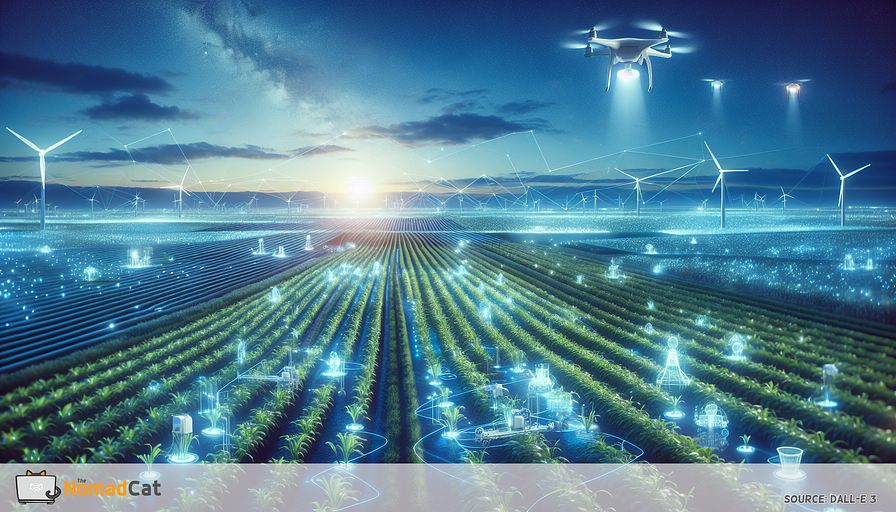Abstract:
The challenge of ensuring food security for all looms large, particularly as our global population continues to soar. Technology, however, is stepping up to meet this critical need through innovative solutions that promise to transform the agricultural sector. From AI-powered predictive analytics for crop management to blockchain-enhanced supply chain transparency, these advancements are making significant strides in reducing waste, increasing efficiency, and improving yields. Additionally, IoT-enabled smart farming techniques are revolutionizing how food is grown, harvested, and distributed, ensuring fresher produce reaches consumers faster and with fewer resources. This article explores how these technological interventions are not just making agriculture more sustainable but are paving the way for a future where hunger is a problem of the past.
Introduction to Food Security and the Role of Technology
As the Chief Technology Officer, navigating the complexities of global food security has become more than a job—it's a pressing challenge where every byte and blockchain leap counts. Food security, the guarantee of adequate and safe nutrition for all, stands as a formidable test amid our ballooning global population. But did you know that by 2050, we might be sharing our dinner tables and planet with as many as 9.7 billion people? The thought alone places immense pressure on our already strained food production and distribution systems.
Enter the heroic trio of technology: Artificial Intelligence (AI), blockchain, and the Internet of Things (IoT). No longer just buzzwords or the culprits behind your weekly screen time report spike, these technologies are evolving into the backbone of modern agriculture. With AI, we're not only predicting tomorrow's weather but also foreseeing planting seasons and crop yields months in advance. Blockchain steps in as the enforcer of transparency, tracing your morning coffee back to the grower whose alarm goes off at 3 AM. Meanwhile, IoT allows farms to communicate directly with handheld devices, ensuring that watering systems and soil sensors deliver just what the crops need to thrive, without a drop wasted.
How, then, do these technologies thread together to sew the fabric of a food-secure future? Let’s untangle this web and explore how each technological player is redefining the field—literally and figuratively. After all, with great data comes great responsibility, and perhaps, the next agricultural revolution is just around the digital corner.
AI and Predictive Analytics in Agriculture
As we venture further into the realm of agricultural technology, let's zero in on how Artificial Intelligence (AI) and predictive analytics are not just reshaping but revolutionizing the agricultural landscape. These tools are like the superheroes of crop management, equipped with capabilities that might seem straight out of a sci-fi novel.
The Power of Predictive Analytics
Predictive analytics in agriculture isn't just about guessing; it's about making smart, data-driven decisions. Using massive datasets on weather patterns, soil conditions, crop health, and more, AI develops models that predict the future with impressive accuracy. For instance, weather prediction models are no longer about whether you'll need an umbrella tomorrow; they inform farmers weeks in advance about the optimal time to sow seeds or harvest crops. This foresight helps maximize yield and minimize crop failure.
Imagine AI as a diligent farmer's assistant that never sleeps. It monitors crops 24/7, identifies disease outbreaks even before they become visible to the human eye, and recommends precise interventions. This use of technology not only improves efficiency but also significantly boosts yield.
Case Studies: AI in Action
- American Midwest Corn Farmers: In the American Midwest, AI-driven systems analyze historical data and current weather reports to advise corn farmers on pest control and irrigation schedules. This has led to a reported 20% increase in yield for participating farms.
- Vineyards in California: Winemakers are using AI to predict vine diseases and optimize irrigation, ensuring the high quality of grapes and sustainability of resources—a toast to technology!
Enhancing Decision Making with AI
AI's role extends beyond just predictions. In regions prone to plant diseases, AI and predictive analytics are equipped with algorithms that detect anomalies and predict plant health issues before they escalate. One such system is Plantix, an app that analyzes images of leaves to diagnose potential diseases. This instant diagnostic tool allows farmers to take immediate action, preventing widespread damage.
These intelligent systems not only protect crops but also preserve the farmer's livelihood. As quoted by a leading agritech expert, "AI in agriculture is like having a crystal ball; it gives you insights that were previously considered unattainable."
The transformation brought about by AI and predictive analytics in agriculture marks just the beginning of a broader movement towards smarter, more sustainable farming practices. Each byte of data analyzed and every predictive model applied sows the seeds for a more food-secure future. Indeed, pushing the frontiers of technology not only secures our food but also preserves the very essence of our natural resources.
As we continue to harness AI and predictive analytics, we are setting the stage for an agri-tech revolution that promises not only higher yields but also a more harmonious relationship with our environment. The fields of the future are not just places of labor but landscapes of data-driven opportunities.
Blockchain for Transparency and Reduced Waste
If you've ever puzzled over the journey of an apple from orchard to fruit bowl or marveled at the odyssey of your morning coffee, blockchain technology might just be the unsung hero of your story. As a tech aficionado and a Chief Technology Officer, I've seen firsthand how blockchain isn't just rewriting the script for digital currency, but also playing a critical role in enhancing supply chain transparency and slashing waste within the food industry.
Decoding Blockchain’s Impacts on Supply Chain Transparency
For the uninitiated, think of blockchain as an immutable digital ledger, recording all transactions across a network of computers. This means every transfer along the food supply chain—from farmers to retailers, and every transit point in between—is recorded in a way that's nearly impossible to alter. This transparency not only builds trust but ensures all players in the chain are held accountable for their roles. Consequently, it leads to significant reductions in food fraud, which not only tarnishes trust but also inflates costs and counts heavily in waste metrics.
I've observed this transformative process in several sectors. The visibility offered by blockchain technology means stakeholders can trace products back to their origins reliably and accurately. It’s akin to having X-ray vision into the journey of food products, where every process they undergo is viewed transparently. This level of insight drastically diminishes the chances of unscheduled detours that can lead to food spoilage or unnecessary surplus—two of the primary culprits behind food waste.
Enhancing Logistics and Inventory Management with Real-Time Data
The real-time data gleaned from blockchain does more than just allow for peeks into the supply chain—it enhances how companies manage inventory and logistics. With immediate updates, companies can more accurately predict the demand and supply cycle, optimizing their stock levels to avoid overproduction and underutilization.
Take, for example, a UK-based supermarket chain that implemented blockchain to manage its perishable goods. With blockchain, the firm was able to monitor the shelf life of products in real-time, reducing food waste by an impressive 20%. This not only ensured fresher produce reached consumers but also streamlined inventory management, reducing excess storage and handling costs, which typically lead to higher carbon footprints.
Success Stories from the Field
- Direct-to-Consumer Coffee Supply: In Colombia, a coffee producer has partnered with a tech firm to use blockchain for tracking the bean-to-cup journey. Consumers can scan a QR code on their coffee pack to view the entire supply chain history. This transparency has enhanced consumer trust and cut down on the waste generally associated with mismanaged produce during transit.
- Italian Olive Oil Tracking: An Italian olive oil manufacturer employs blockchain to certify the authenticity and quality of its oil. By documenting every step of the process, from farming to the retail shelf, they’ve effectively eliminated common points where adulteration or mislabeling could occur, effectively ensuring that only the highest quality, unspoiled oil makes it to the kitchen.
These real-world applications demonstrate just how transformative blockchain can be in untangling the often knotted threads of our global food supply chains. By ensuring each participant in the supply chain—from the farmer to the fork—is transparent, accountable, and efficient, blockchain technology doesn't just save costs; it saves our food resources too.
As we push forward with integrating more blockchain technology into the agricultural sector, the dream is not only of higher yields but also an ecosystem where waste is significantly curtailed, and trust in food quality and origins is restored. The role of technology in agriculture is redefining not just the landscape but potentially every meal we sit down to. It’s not solely about planting coding seeds; it's about harvesting trust and sustainability in every bite we take, enabled by blockchain.
IoT and Smart Farming Techniques
As a Chief Technology Officer deeply immersed in the agricultural sector's advances, I've seen first-hand how the Internet of Things (IoT) is more than just a stream of data—it's a surge of opportunities fundamentally changing farming practices. IoT in agriculture, often termed as Smart Farming, isn't just about fancy gadgets and wireless sensors; it's about making farming more sustainable and efficient through intelligent resource management.
Optimizing Farm Resources with IoT
One of the core benefits of implementing IoT devices in agriculture includes optimizing the management of water, soil nutrients, and crop health. Smart sensors deployed throughout fields gather data on everything from soil moisture and nutrient levels to temperature and crop health, transmitting this information in real-time to farmers and agricultural scientists. This data-driven approach allows for the precise application of water, fertilizers, and pesticides, only where and when they are needed, minimizing waste and environmental impact.
The precision doesn't stop there. Imagine smart irrigation systems that water crops based exactly on the soil and weather conditions. If the soil moisture level drops below a certain threshold, these systems kick into gear without human intervention, ensuring crops get exactly what they need for optimal growth. Additionally, drones fly above fields, equipped with cameras and sensors that monitor crop health and growth patterns, highlighting areas that need attention. This bird's eye view not only saves farmers a stroll but also saves crops from potential yield pitfalls.
Data-Driven Decisions and Sustainability
The meticulous data collected by IoT devices doesn't just help with day-to-day farm management; it shapes a farm's strategy toward sustainability. By analyzing patterns over time, farmers can make informed decisions that boost productivity while preserving the environment. For instance, data on crop rotation effectiveness and pest population dynamics can help in planning the best crop sequences and pest management practices without resorting to excessive chemical use.
Moreover, these smart systems are not limited to large industrial farms. Smaller, family-run farms are finding that these technologies can be scaled to fit their operations, helping them compete with larger entities by increasing yield and reducing resource expenditures. This democratization of technology fosters a more inclusive agricultural community where sustainability and efficiency go hand in hand.
Transforming Farms: A Real-World Example
- Corn Farm in Nebraska: A small family-owned farm in Nebraska recently adopted IoT technologies, and the transformation was nothing short of remarkable. With soil sensors, they could reduce their water usage by 25% while maintaining crop yield. Real-time data analytics helped them detect a fungal outbreak early, saving a significant portion of their crop that would've been lost. They not only cut costs dramatically but also reduced their environmental footprint, illustrating the profound impact of IoT in practical scenarios.
The implementation of IoT in agriculture is paving the way for farms that are not just food sources but also stewards of sustainability. As we continue to integrate these smart technologies, the relationship between agriculture and technology grows deeper, promising a future where farms operate as efficiently as any high-tech facility, with the added benefit of nurturing the planet. In a world grappling with climate change and food security, smart farming stands as a beacon of hope, ensuring that we meet today's needs without compromising tomorrow's resources.
The tale of that Nebraska farm is just a snippet of IoT's potential in revolutionization agricultural practices worldwide. It’s a potent reminder that technology can indeed restore balance to our food systems and help us grow towards a sustainable future. As we move forward, IoT's role in agriculture is bound to expand, taking us closer to achieving food security and environmental sustainability through smarter, data-driven farming practices.





